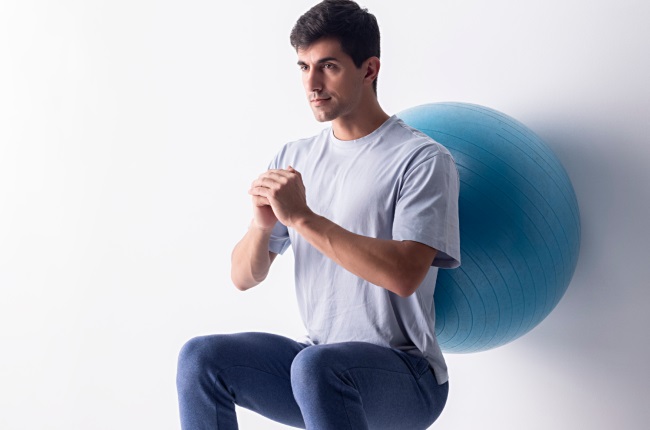
Keeping your knees in tip-top shape is vital for long-term flexibility and joint health. So how can you maintain strength and flexibility in these vital joints? Start by incorporating these smart ideas from top physios and fitness experts into your weekly workout regimen.
Get moving
The best way to prevent knee degeneration is regular exercise, says Australian exercise physiologist and sports scientist Courtney Hargrave – and the earlier you start the better. When you move your knees, synovial fluid is secreted from the cartilage and this provides lubrication to the joint, she says, preventing wear and tear and premature degeneration, plus it provides nutrients to the cartilage.
Knee action
While some people can tolerate high-impact exercise such as running and jumping, these activities can promote the onset of degenerative conditions such as osteoarthritis in others, Hargrave says. It may be better to err on the side of caution and focus on low-impact aerobic activities instead.
Other exercises to be approached with caution include anything that involves repetitive knee movements such as deep squatting, stair climbing and stepping, particularly if they’re done with heavy resistance.
Watch your weights
Although osteoarthritic knees need strengthening, traditional squats and lunges can be aggravating, Australian physiotherapist Anna-Louise Bouvier says.
Knee action
Build strength in your knees slowly by starting with modified squats – so only squat down to a point where you have no pain and do it with your back against a wall or with a Swiss ball placed between you and the wall.
Even those with healthy knees need to be wary of open-chain equipment-based exercises in the gym – these are ones where your feet lift off the ground, such as seated leg extensions or hamstring curls.
These moves can be problematic as they can load and stress the knee joint, says Karen Finnin, director of physios-online.com
Instead, focus on closed-chain exercises such as squats, lunges or leg presses. What this means is that the soles of your feet are in contact with the floor or a foot plate all the time and the joint is stabilised.
Always warm up well to get synovial fluid flowing before a weights session.
Get fit and have fun with your friends at Saturday Night Fitness – our besties special double ticket is only R350 for both of you if you buy together! Don’t miss out – get your ticket HERE
Get stretchy
Tight muscles pulling from different angles on your knees can cause pain and affect the way your knee tracks.
Knee action
Pay particular attention to daily stretching of your hip flexors, quads, ITBs (the iliotibial band, which is on the outside of the thigh), ankles, calves and glutes.
Check your alignment
Try this test: do a small squat keeping your back straight and your heels on the ground. Freeze and look down – is the space between your knees smaller or greater than the space between your feet?
It should be the same, says Finnin. “Even a tiny biomechanical fault with the way our kneecaps move can become a problem given enough repetition.
“Think how many times your knees bend and straighten every day,” she says.
Knee action
Poor knee alignment usually indicates weak VMO (vastus medialis obliquus) muscles. This is the inside part of your quadricep above the knee. An excellent strengthening exercise is this straight-leg raise:
- Lie on your back. You can prop yourself up on your elbows if it’s more comfortable.
- Rotate your right leg very slightly outwards.
- Squeeze your quad and lift the leg up straight, about half a metre off the floor.
- Lower the leg nearly to the floor, then lift again.
- Repeat to do a set of 20 and then do the same with your left leg.
- Perform two sets of 20 reps on each side every day.
In addition, when you perform squats at the gym do them in front of a mirror so you can ensure your knees are lined up over your toes.
“It can help to think of lifting the arches of your feet or holding a beach ball between your knees,” Finnin adds. “But take care not to over-correct. The solution is not to simply stand on the outside edges of your feet – you still need all your toes on the floor.”
Improve hip function
“New research is showing the deep buttock muscles of the hip play a critical role in taking the load off the knee and are often weak in people with osteoarthritis,” Bouvier says.
Women with very wide hips are particularly prone to knee arthritis. Strong hips allow better control of the femur (thigh bone), which improves knee stability.
Knee action
- Strengthen your glute muscles with Pilates. You can also try these froggy glute lifts:
- Lie on your tummy and rest your forehead on your folded arms in front of you.
- Bend your knees to 90 degrees and move them so that they’re shoulder-width apart, then press your heels together and flex your feet.
- Squeeze your glutes to lift your knees off the floor, hold, then lower.
- Do 10 reps, then 10 pulses and repeat.
Watch your weight
Being overweight creates a vicious cycle, says Australian physiotherapist Anna-Louise Bouvier. Research published in the Medical Journal of Australia found that from the age of 30 there’s a 36% increased risk of osteo-arthritis for every 5kg over your recommended BMI.
Knee action
Unfortunately, the more activities that hurt your knees, the harder it is to find an exercise that will help you lose weight.
However, swimming is fantastic for knees, sports scientist Courtney Hargrave says.
Another exercise that works well for those whose knees take strain is the elliptical trainer – it’s low impact and many find it that reduces stiffness and inflammation.
Stand up straight
People who stand slumped with all their weight on one leg may feel comfortable but in the long term it switches off the deep buttock muscles and creates problems for both the hip and knee joints.
Knee action
Be aware of balancing your weight evenly between both legs and also between the front and back of both feet when standing. “Imagine you have a light shining out of your chest and lift it so it’s shining straight forward,” Bouvier says.
READ MORE| Here are 5 stretches you can do to prevent aches and stiffness after a long day at work
Get pain checked
Knee pain can have a variety of causes, including the biomechanics of your knee, cartilage degeneration, musculoskeletal imbalances, inflammation or injuries such as ligament damage, meniscus tears or even a fracture.
Knee action
Visit a physiotherapist or doctor who can diagnose the problem, prescribe treatment and give you customised stretches, or alternative ways to exercise without aggravating the problem.
Remember that cartilage and ligaments have very limited blood supply, so healing can take a long time.




 Publications
Publications
 Partners
Partners



















